Preserving the charm of historical areas, reducing interfaces with civil works, simplifying underground network deviations, easing access to fire brigades and maintenance employees, etc. catenary-free systems offer a promising future for trams in urban environments. In this article, SYSTRA experts Mathieu Mélenchon and Frédéric Rouquette, System Engineering Managers, Daniele Coldebella, System Engineering Centre Director, Luciano Consoli, Rolling Stock Expert, and Maud Bernard, Innovative Transportation Systems Programme Director, evaluate the advantages and constraints of three catenary-free systems: continuous ground level power supply systems, on-board energy storage, and hydrogen powered systems.
1. SYSTEMS STUDIED
Historically, a railway electrification system supplies power to the trams/LRT through an Overhead Catenary System (OCS). Such a system consists of poles placed along the line at a regular distance supporting feeding wires: it takes space and, even if relatively inconspicuous, is still visible which can be an issue in some historical areas.
In order to limit the aesthetics impacts (on a part of the line, or on the whole line) or to cope with a restricted environment (e.g. narrow right of way), some alternatives have been developed in the past decades. Several catenary free systems exist and could be proposed depending on the site configuration. Unfortunately, the existing solutions involve an increase of the lifecycle cost of the project, as compared with the efficient, standardized, proven-design OCS. The objective of this paper is to list potential solutions, identify the conditions of implementation, advantages, and drawbacks to evaluate their relevance for an urban LRT/tram system.
Before evaluating which solution could be proposed, it is necessary to estimate the portion of the line on which the overhead contact line cannot be installed.
There are several types of ’catenary-free’ systems available on the market, we will focus on the three solutions that we consider relevant for an urban environment (i.e. diesel-powered vehicles are not studied there):
- Continuous Ground Level Power Supply Systems: This system allows power to be drawn from the ground level continuously with contact or contactless;
- On-Board energy Storage: these solutions all rely on an on-board energy storage device which supplies the LRT while running without an overhead catenary. This storage is loaded in specific sections of the line or in station, power could be supplied either by catenary or by ground collection;
- Hydrogen-powered systems: The train carries a hydrogen tank and fuel cells, and produces electricity by combining hydrogen and oxygen. Energy produced is stored in an OBS.
The two first systems could be currently considered as mature, while the hydrogen powered systems is a recent alternative with a lack of operating experience.
2. BENEFITS FOR THE PROJECT OF IMPLEMENTING A CATENARY-FREE SOLUTION
2.1 Aesthetics
The first benefit of having a Catenary-Free system is mainly aesthetic. Implementing a catenary-free solution minimizes the visual impact caused by overhead lines & masts. Indeed, a catenary-free solution is commonly installed in projects where there are strong urban stakes. A Catenary-Free System does not obstruct the charm and view of old parts of the cities :
- Emblematic places;
- Near historical buildings or within historical areas;
- City Centre.
2.2 Technical
Catenary-free solutions also have technical benefits to minimize the following constraints :
- Underpass: existing infrastructure could be relatively low and could constitute a hurdle for a catenary system;
- Fire Brigade access: in some particular sections, a catenary system could be a risk for firemen due to its proximity to buildings, demanding specific procedures;
- Low EMC/EMI values: hospital, labs, or other sensitive buildings along the corridor could impose stringent EMC/EMI levels not always compatible with a catenary system;
- Reduce right-of-way width: in some narrow environment (e.g. city centre): it could be difficult to integrate the track and the catenary system;
- Reduce or simplify the maintenance works of the catenary system environment (e.g. reduction of the tree pruning effort along the corridor, simplification of the access to equipment close to the catenary line such as public lighting).
In these cases, a catenary free system offers the benefits of providing a traction power supply without being in interface with a civil works system.
2.3 Criteria to consider
What comes with benefits often comes with drawbacks or limitations, which is the case for our three catenary-free systems. In order to estimate the relevance of switching to a catenary-free solution and if confirmed, selecting the most suitable solutions given the context, some criteria would need to be considered such as:
- Main characteristics of the line (e.g. topography, available space) and the expected performances (e.g. commercial speed);
- Local climatic conditions: Ability to cope with adverse weather conditions such as heavy rain or snow;
- Electromobility ecosystem that could be impacting for hydrogen-based solutions;
- Maturity of the solutions and existing competition;
- Lifecycle costs, consisting of the investment effort and the recurrent costs during the operation, as compared to an Overhead Line System.
3. THE CONTINUOUS GROUND LEVEL POWER SUPPLY SYSTEMS
3.1 Main characteristics
The power is provided to the vehicle through a contact line embedded in the permanent way. A mandatory condition to release power is the presence of the vehicle over the segment. The contact line is composed of consecutive modules insulated between each other. Size of each module and the mechanism to energize them depends on the manufacturer and the energy collection. Energy transfer to on-board equipment could be done mechanically from a contact shoe or by induction through pick-up coils beneath the vehicle forming a secondary circuit that converts the energy of the magnetic field into electricity.
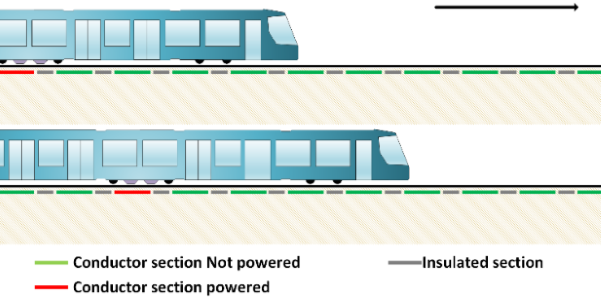
Alstom, Ansaldo and Bombardier are offering continuous ground level power supply solutions.

3.2 Main advantages and constraints /limitations
The aim of this section is to identify the advantages, constraints, and limitations to estimate the relevance of the solution for a given configuration.
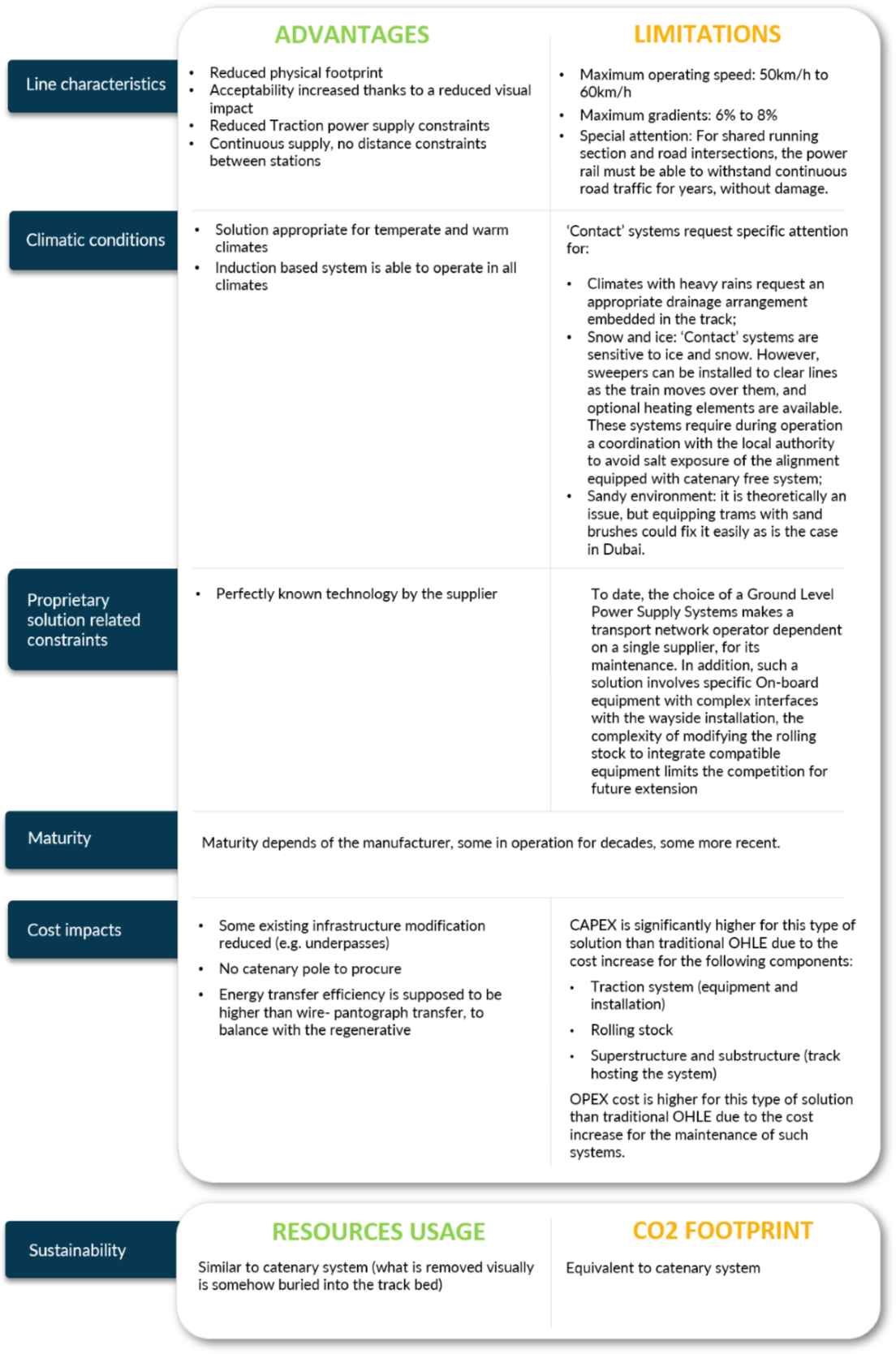
4. ON-BOARD ENERGY STORAGE
4.1 Main characteristics
The principle is simple: batteries or batteries + supercapacitors are charged and act as on-board energy storage containers. Prior to use, the energy storage must be sufficiently charged, which is done either during off-service times at stabling yards or while in service at charging points (through catenary or through a localized ground level power supply system).
Once the tram leaves the charging area and accelerates up to its operational speed, the traction energy storage begins to discharge and bears the power loads of the vehicle electric motors and any other auxiliary equipment such as HVAC systems or electric doors. Upon reaching operational speed, batteries or batteries + supercapacitors efficiency is maximized by only drawing power when coasting speed is reduced. During deceleration of the tram at a stop or at a curve, regenerative energy derived from excess heat and kinetic energy is released from the traction motors unit to recharge the energy units further increasing batteries/batteries + supercapacitors efficiency.
The benefit of using super capacitors is to make possible the transfer a great volume of energy in a short period. The super capacitors are charged at passenger stations during the dwell time which should last between 20 and 30 seconds, depending on the length and gradient between stations. Charging points could be set at different locations of the line.

4.2 Main advantages and constraints /limitations
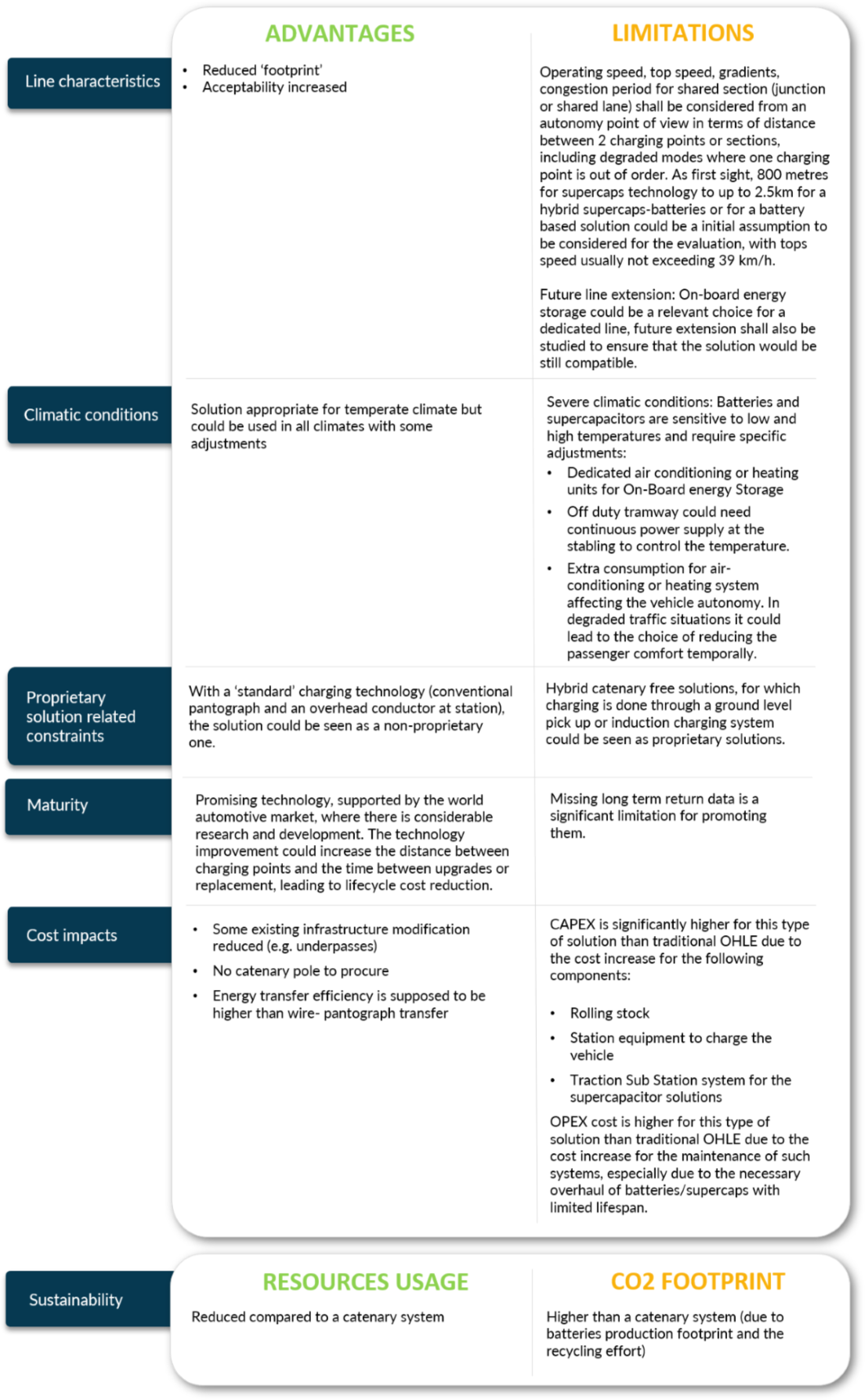
5. HYDROGEN SYSTEM
5.1 Main characteristics
Fuel cells are able to generate power from hydrogen gaze and air via an electrochemical reaction releasing only pure water. Due to the solution slow dynamic of operation and start-up, fuel cells could not meet a light rail vehicle’s demands. They need to be associated with other storage systems to compensate. Currently the most efficient combination is:
- Fuel cells, used as the main power source providing the majority of the demand;
- On-board Energy Storage (batteries and supercapacitors) used to supplement the Fuel cells output power during vehicle start-up and during high load demand (acceleration or slope).The energy recovery during braking is captured by this On Board Storage.
The combination of these technologies (fuel cells, batteries, supercapacitors) aims to maximize their benefits while avoiding the weaknesses of each one.
- Fuel Cells: Proton Exchange Membrane Fuel Cell (PEMFC), the fuel cell leading technology has good power capability during steady-state operation, but cannot properly handle rapid power demand variations. In addition, Fuel Cells cannot store energy collected for the regenerative braking. For this reason, OBS are required to take over this power load during the peak demands and store the energy recovery during braking.
- On-Board Energy Storage (Super Capacitor combined with Battery system): Combining the two technologies, battery and supercapacitor, would make a good compromise compensating their individual limitations.
Such hydrogen systems require a complex Energy Management System to coordinate the different power sources enabling an efficient power distribution. The objective is to reach a balance between power source efficiency and optimized lifetime.
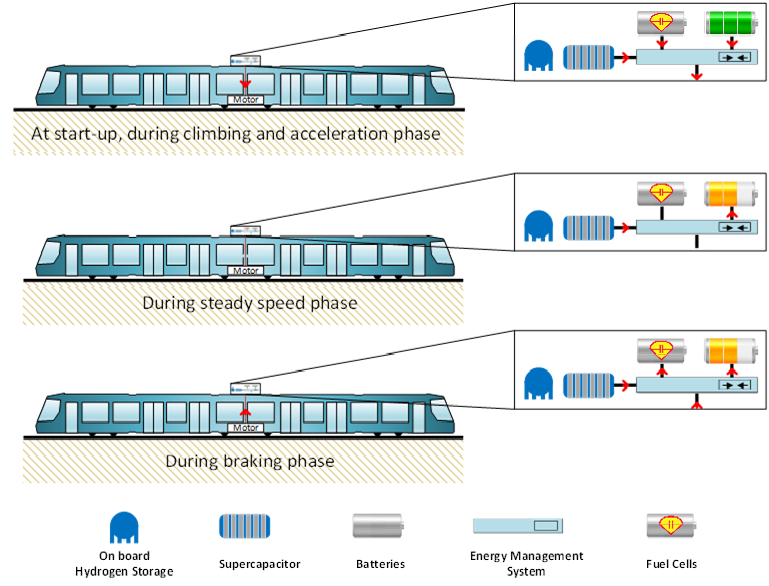
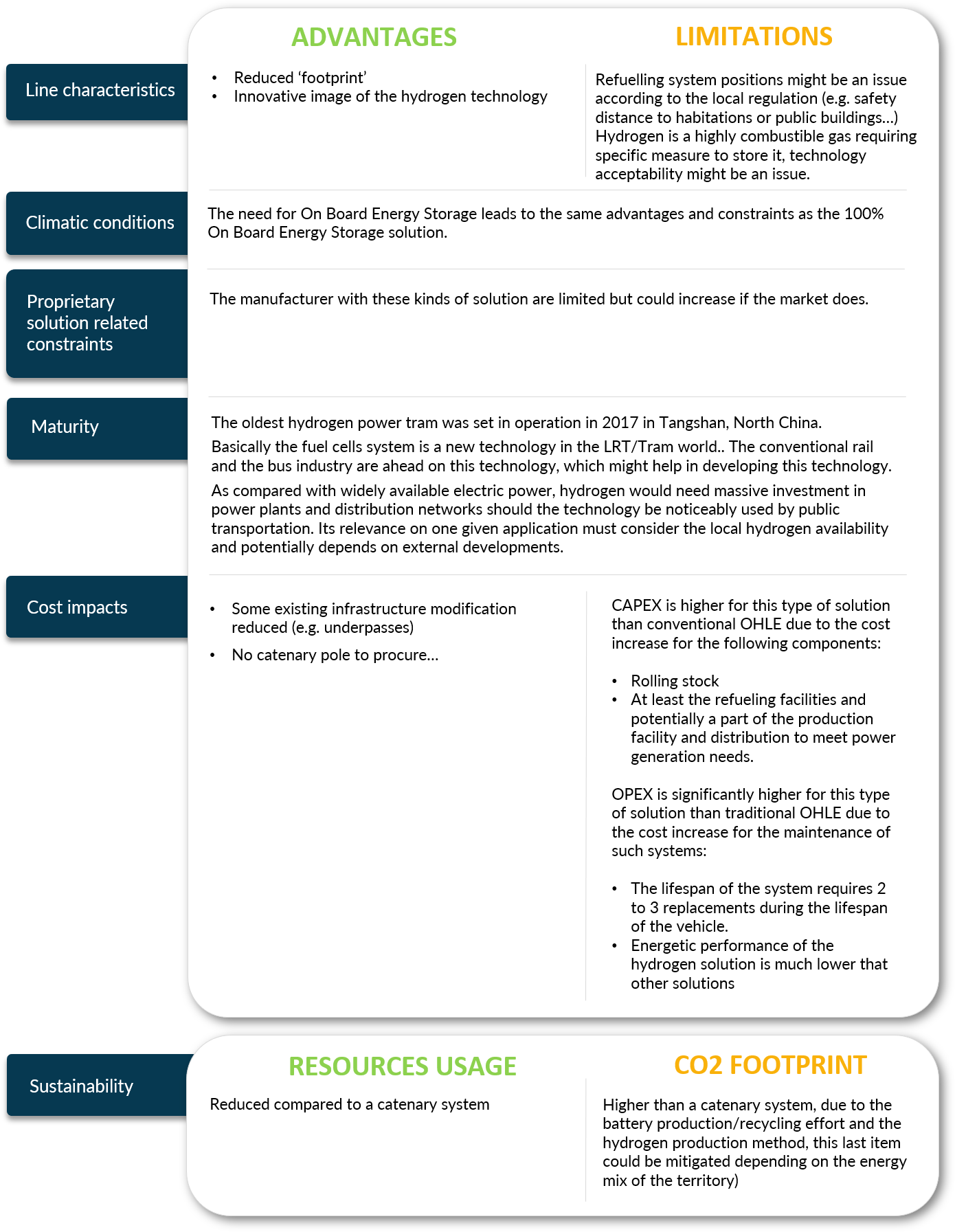
6. EVOLUTION
5.2 Main advantages and constraints
This document lists the different technologies available to remove partially or totally the catenary system of a tramway project. The pros and cons of each solution are current but things are evolving quickly. From a technology standpoint: the automotive industry is investing a lot to reduce the carbon emissions of the future road vehicles, while on board energy storage and hydrogen fuel cells performance are improving constantly. From the ecosystem standpoint: particularly true for the hydrogen-based solution, the lack of refuelling infrastructure is a critical issue. The necessary investment is too high for a tramway line alone but if infrastructure is available for private vehicles, trucks, or other public transport mode (such as buses), the equation could change.
The public buses are migrating to a zero-emission solution, moving the line for the future tramway and enabling technologies to move from ’promising’ to ’standard’ and reducing the investment and operation costs of catenary-free solutions.
 Australia
Australia  Brazil
Brazil  China
China  Denmark
Denmark  France
France  India
India  Indonesia
Indonesia  Ireland
Ireland  Italy
Italy  Malaysia
Malaysia  New Zealand
New Zealand  Norway
Norway  Poland
Poland  Saudi Arabia
Saudi Arabia  Singapore
Singapore  South Korea
South Korea  Sweden
Sweden  Thailand
Thailand  United Kingdom
United Kingdom  United States
United States  Taiwan
Taiwan  Vietnam
Vietnam